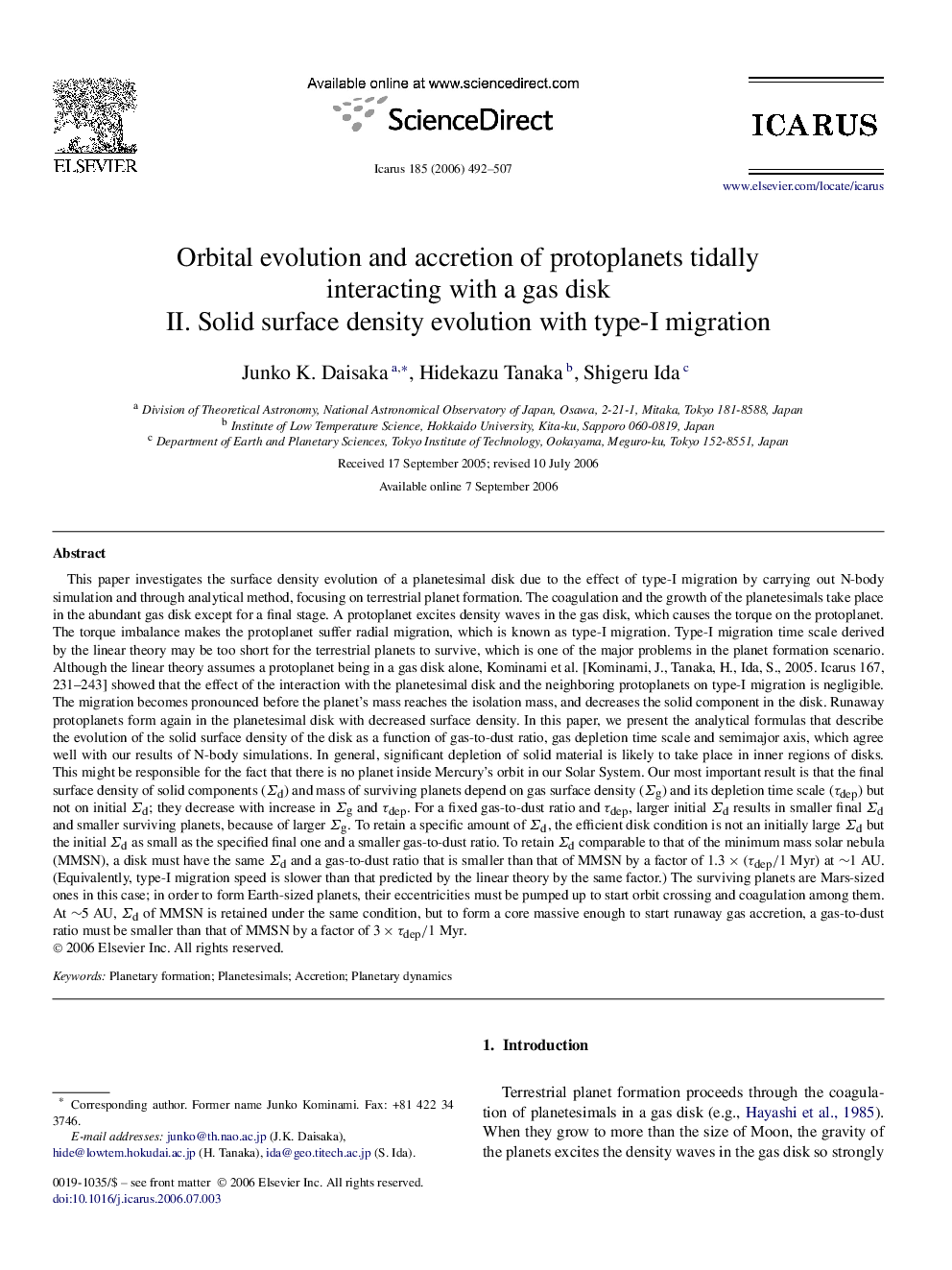| کد مقاله | کد نشریه | سال انتشار | مقاله انگلیسی | نسخه تمام متن |
|---|---|---|---|---|
| 1775511 | 1021196 | 2006 | 16 صفحه PDF | دانلود رایگان |

This paper investigates the surface density evolution of a planetesimal disk due to the effect of type-I migration by carrying out N-body simulation and through analytical method, focusing on terrestrial planet formation. The coagulation and the growth of the planetesimals take place in the abundant gas disk except for a final stage. A protoplanet excites density waves in the gas disk, which causes the torque on the protoplanet. The torque imbalance makes the protoplanet suffer radial migration, which is known as type-I migration. Type-I migration time scale derived by the linear theory may be too short for the terrestrial planets to survive, which is one of the major problems in the planet formation scenario. Although the linear theory assumes a protoplanet being in a gas disk alone, Kominami et al. [Kominami, J., Tanaka, H., Ida, S., 2005. Icarus 167, 231–243] showed that the effect of the interaction with the planetesimal disk and the neighboring protoplanets on type-I migration is negligible. The migration becomes pronounced before the planet's mass reaches the isolation mass, and decreases the solid component in the disk. Runaway protoplanets form again in the planetesimal disk with decreased surface density. In this paper, we present the analytical formulas that describe the evolution of the solid surface density of the disk as a function of gas-to-dust ratio, gas depletion time scale and semimajor axis, which agree well with our results of N-body simulations. In general, significant depletion of solid material is likely to take place in inner regions of disks. This might be responsible for the fact that there is no planet inside Mercury's orbit in our Solar System. Our most important result is that the final surface density of solid components (ΣdΣd) and mass of surviving planets depend on gas surface density (ΣgΣg) and its depletion time scale (τdepτdep) but not on initial ΣdΣd; they decrease with increase in ΣgΣg and τdepτdep. For a fixed gas-to-dust ratio and τdepτdep, larger initial ΣdΣd results in smaller final ΣdΣd and smaller surviving planets, because of larger ΣgΣg. To retain a specific amount of ΣdΣd, the efficient disk condition is not an initially large ΣdΣd but the initial ΣdΣd as small as the specified final one and a smaller gas-to-dust ratio. To retain ΣdΣd comparable to that of the minimum mass solar nebula (MMSN), a disk must have the same ΣdΣd and a gas-to-dust ratio that is smaller than that of MMSN by a factor of 1.3×(τdep/1 Myr)1.3×(τdep/1 Myr) at ∼1 AU. (Equivalently, type-I migration speed is slower than that predicted by the linear theory by the same factor.) The surviving planets are Mars-sized ones in this case; in order to form Earth-sized planets, their eccentricities must be pumped up to start orbit crossing and coagulation among them. At ∼5 AU, ΣdΣd of MMSN is retained under the same condition, but to form a core massive enough to start runaway gas accretion, a gas-to-dust ratio must be smaller than that of MMSN by a factor of 3×τdep/1 Myr3×τdep/1 Myr.
Journal: Icarus - Volume 185, Issue 2, December 2006, Pages 492–507